


Lilian Partleton (1864-1909)
This page is a continuation of the web page of Lilian's father Henry Partleton (b c1838). Click here to read his page first.
On 06 April 2009 I caught the tube to Victoria Station and walked along Victoria Street to meet up with Terry Partleton at Westminster Archives, circled in blue below. We'd visited this place, close to Westminster Abbey, a number of times before. Time really flies at the archives, but by lunchtime we were drawing a complete blank, as sometimes happens when trawling through endless pages of microfilms.

In the lobby of Westminster Archives I chanced upon this leaflet:
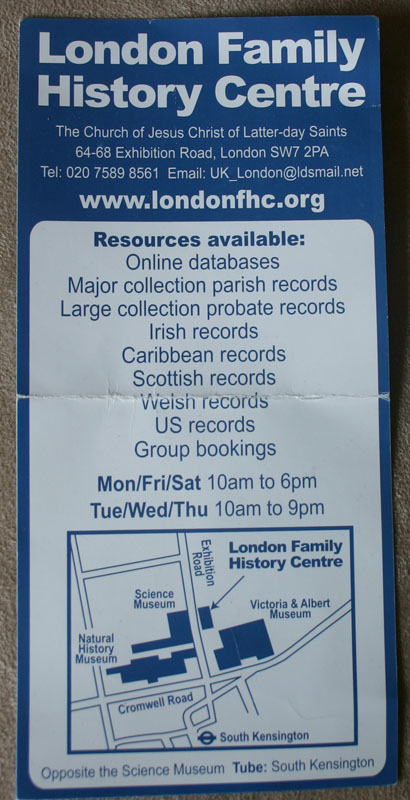
The archives of the Church of Jesus Christ of Latter-day Saints [often abbreviated to the LDS] are well known to anyone researching family history because the database is available online, free of charge, to everyone, at familysearch.org. But if you want to see copies of the original documents, you have to make a visit in person to one of the LDS Family History Centres. So this leaflet seemed to present a perfect opportunity to make better use of the remaining part of the day.
I will level with you here... I'm not a big fan of organised religion, and I had always veered away from turning up in person at the LDS. One might be evangelized or proselytized, both of which sound very painful. You might come out with a bible under your arm and a 1000-yard stare in your eyes.
Actually, none of the above happens. The LDS are located in South Kensington, directly opposite a building which was assuredly my favourite place in the whole world when I was 12 years old - the Science Museum. It's in the red circle below:

The Family History Centre is a small, hushed, scholarly basement of the very grand LDS building which - frankly - emanates enormous wealth. The archive is supervised by very helpful, quietly-spoken, sober, austere-looking American Mormon gentlemen dressed in black suits. There's no evangelizing, and, though sombre, it's quite friendly.
So, after a short hop on a London bus, Terry and I were in the LDS archive. Our objective was to see the Parish Registers of Barbados of the mid-19th century.
Here's one of the documents we found: Lilian Georgiana Partleton, born on 28 March 1864:

Lilian's mum and dad are poor. The humble roof over their heads is provided free, courtesy of the charity of the Parish of St Philip. Her dad Henry is described as a coachman. Old job titles don't always convey much to us, so here's a photograph of a Victorian coachman to nudge our imagination. Coachmen had reputations of being a bit rough around the edges, a bit bluff and blunt, much like cab drivers do today:
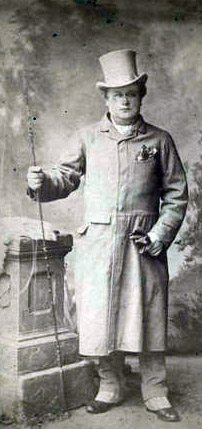
At some time during the three years after baby Lilian's birth, her dad Henry Partleton disappears. He may have died, he may have run off, we don't know. In 1867 Lilian's mum has another baby, Rosina Albertina, illegitimate. Selina has no money, no breadwinner, no income, and three little girls to care for. She is in big trouble.
Then the record goes silent.
At this point I think it's a good idea to have a look at baby Lilian's family tree. Lilian is shaded in pink:
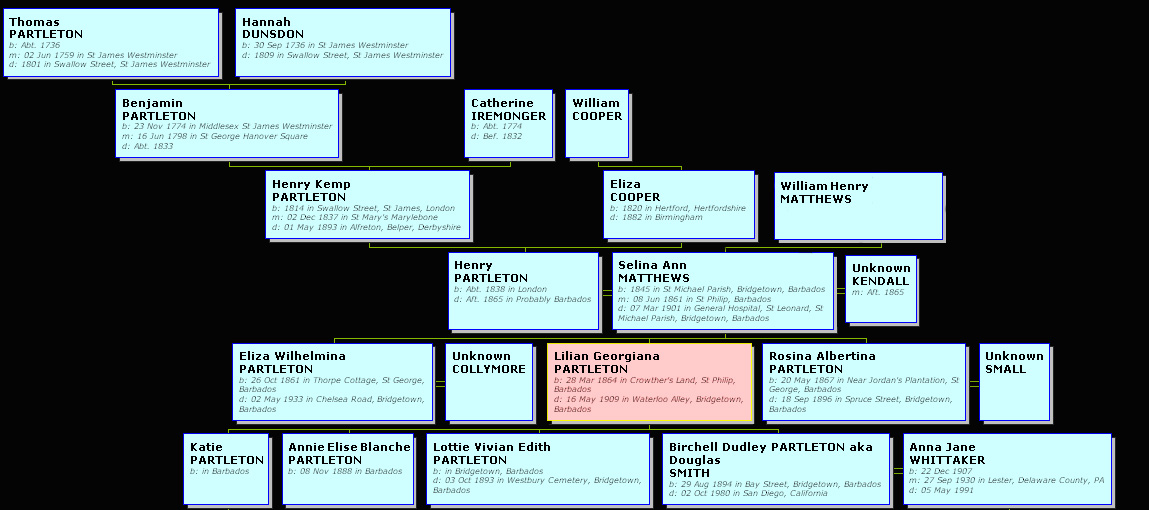
Let's have another look at Lilian's baptism:

Lilian's place of birth, recorded in the Parish Register as Crowther's Land. We know that it adjoins the Sunbury Plantation, which is circled red below:

Here's Sunbury Plantation House, exactly as it looked in 1864, located in the green circle above:

And here's the Church of St Philip, where Lilian was baptised in 1865:

The church is in the blue circle in the map:

Wouldn't it be marvellous if, as we see in the topographic map below, we could step into Henry and Selina's shoes and look north towards St Philip's church and the Moncrieff ridge behind it...

Well, thanks to 19th-century artist Robert Schomburgk, who must surely have known that we would need his lithograph on the internet one day in the future, we get a lovely view, from the viewpoint of the green arrow, which I'd guess is drawn from an upstairs balcony in the Sunbury Plantation house in 1847.
Ok, I know I've used this picture before, but it's just too good to waste.
There's no question that little Lilian must have walked along this road as a little child, so let's step into their shoes, feel the tropical heat and go for a stroll on that undulating country lane, perhaps the songs of the plantation workers carried on the breeze:

The cottage where Lilian was born, on Crowther's Land, may even be one of the ones in the picture. It would be on the left, as Crowther's Land adjoins both the Sunbury Plantation and Carrington's Plantation which is to the west of Sunbury.
I wanted to illustrate Lilian's rural beginnings. We see windmills in the engraving above, for crushing the sugar cane. Here's a windmill in a plantation amidst the heat and sunshine on Barbados; I think it's fair to say we can step into her small shoes, if she has any, and run among the sugar canes:

Henry Partleton had picked a really bad time to disappear. How Lilian's mum Selina managed after her the passing of her husband we can only speculate. Barbados in the second half of the 19th century was suffering desperate economic hardship resulting from recurring crashes in the sugar price. Selina and her three little girls, including our Lilian, are in a very vulnerable position. There's no welfare state, and what charity is available would have to be very thinly stretched.
So Lilian's childhood was not going to be easy, whichever way one looks at it. At some point she gets a stepfather, for good or for bad. His surname name was Kendall; we know no more about him. But the remarriage of her mother is evidence that her father must be dead - unless, of course her mum lied about that in order to remarry.
By the time Lilian has grown up, she has left the countryside and is in the only city on the island, Bridgetown - the capital, which you'll see circled in green in the map below.

We know Lilian is in Bridgetown because at age 22 she surprises us by giving birth to an illegitimate child in 1886:

And two years later, Lilian has another daughter, Annie Elise Blanche Partleton:

No father is named; the baby is again illegitimate - a circumstance which is common enough in Victorian times. A young woman has become pregnant, and the father has skedaddled, fair enough. The Victorians were not sympathetic to girls in Lilian's condition, and single mums always had a very hard time of it - but Lilian's situation is more serious, as we shall see later on.
Again this is pretty bad timing. The price of sugar on the London market had plummeted in 1886, causing still further economic depression in Barbados. There's no work, no end to this. How is Lilian going to earn a crust and feed her babies?
Also of interest to us is this observation: little baby Annie Elise may not know it, but although her granddad Henry Partleton (1838) is probably dead, her great-granddad Henry Kemp Partleton is still very much alive, aged just 74, and is still a travelling actor back in England. How much did old Henry know about what was happening to his grandchildren and great-grandchildren in Barbados?

This is a good moment to bring in Lilian's third child, Douglas, who, from a recording of 1980, can fill us in on exactly what is happening in Lilian's life, starting with Doug's sisters Katie and Elise [given name Annie Elise whom we saw being born a little earlier]. Click on the video below to hear Doug:
We learned so much in that short clip, we need to review some of the startling facts revealed by Douglas. Firstly, we discover that Lilian Partleton has fallen on such dire straits at age 24 that she has had to turn to prostitution. Her three children are to a greater or lesser degree unwanted results of her profession; so much so, indeed, that she abandons poor little Douglas at age 4 into the permanent care of a black neighbour and never shows him any love as he tries to maintain contact with her.
Secondly, we hear confirmation that Lilian's mum Selina Partleton nee Matthews has indeed remarried and is now called Selina Kendall. Let's have a quick look at Douglas' birth certificate, in which we get to see his real birth name Birchell Dudley St Aubry Partleton:

Unfortunately, the Barbados records office do not provide images of the original records - this is a modern transcription, and not a very good one, which is a shame. Note that both Lilian's and Douglas' surnames are incorrectly spelled as PARLLETON.
But note also that the Informant is 'Celsua Kendal'. Having scoured the internet, I can tell you that there is no such name as Celsua, so we have to decide: is this a person with a unique name, or is this just another transcription error? I certainly believe that the informant is Lilian's mother Celina [Selina] Kendall.
Here's another look at that tree to help us with the relationships:

Lilian had at least 8 or 9 children as a consequence of her life as a prostitute and we may presume that many of them died at birth or in infancy. Here's the burial of baby Lottie Vivian Edith Partleton in 1893, a year before Doug was born. It's fair to say that she is probably a baby of Lilian's, though assumptions are dangerous and she she could bear some other relationship:

Doug tells us that he only met his grandmother Selina once, when he was 5 or 6 [that would be c1899] and that she was living in the almshouse at Bridgetown, ie the poorhouse. I have found a picture of it:

Believe me, that picture took some finding!
Here's a slightly longer version of Doug's story about his grandmother, and he says the alms house was a "beautiful little place". I'm inclined to agree it looks a pretty setting for Selina to spend her last years, and hopefully may have given her some comfort from the hardships which she has no doubt endured bringing up her three little girls without their father.
Selina must have known that her daughter was making a living from prostitution - you'll have to decide for yourselves how she felt about this, whether indeed she had been a prostitute herself and what her role was in this catastrophe. The simple fact was that there may have been no other way to stay alive.
She died within two years of Doug's visit to the almshouse, on 07 March 1901, aged 56:
Selina had had a tough life, steeped in poverty, and died in the hospital at St Leonard in St Michael Parish and was buried in Westbury Cemetery, Bridgetown, which we see in the modern photograph below. Unsurprisingly, no tombstone exists, according to the Caribbean genealogy website www.tombstones.bb

At this point, I want to rewind, and to remind ourselves, now that we have seen her death, that - back in the 1860's - Selina Partleton had three daughters, one of whom is our Lilian. What became of Lilian's sisters, Eliza Wilhelmina Partleton (b1861) and Rosina Albertina Partleton (b1868)?
Did they also have to turn to prostitution?


I think this is the burial of Eliza Wilhelmina in 1933. It's the only one in Barbados with that unusual combination of given names, and it matches within one year of her birth date. She has married a man of the name Collymore and may have left descendants of that surname. Interestingly, Eliza's tombstone does still exist in Westbury cemetery.
OK, let's get back to Lilian Partleton. In 1901, her mum has passed away and she's on her own with her two illegitimate daughters, one of whom still lives with her, and her son Douglas, living away from her, whom she has all but disowned. Her address is Bay Street, circled in green in the map below, close to Bridgetown's red-light district on Nelson Street, circled in red:
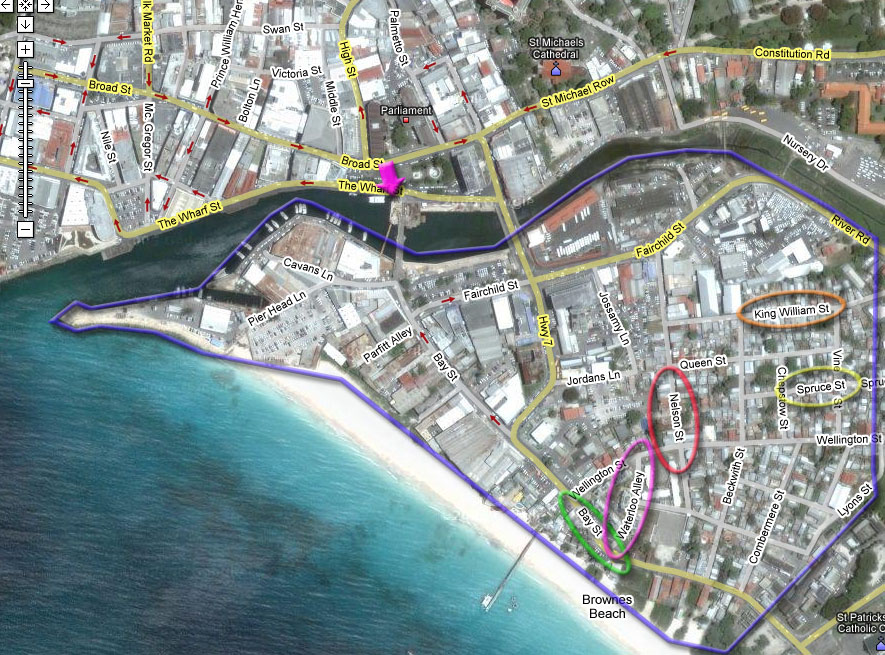
Chelsea Road, where Eliza Wilhelmina died in 1933, is just off the map to the south.
In the photo below, from the viewpoint of the purple arrow in the map, we can see Chamberlain Bridge and Bay Street behind it, curving away towards Lilian's residence, 250 metres off picture in the direction of the green arrow

Try as I might, I could not find any pictures of the poor part of Bridgetown where Lilian lived, Pondside, of the time when she lived there. Below are some modern pictures of Nelson Street, the centre of Bridgetown's red light district in Lilian's time, and remains so today [2011]:
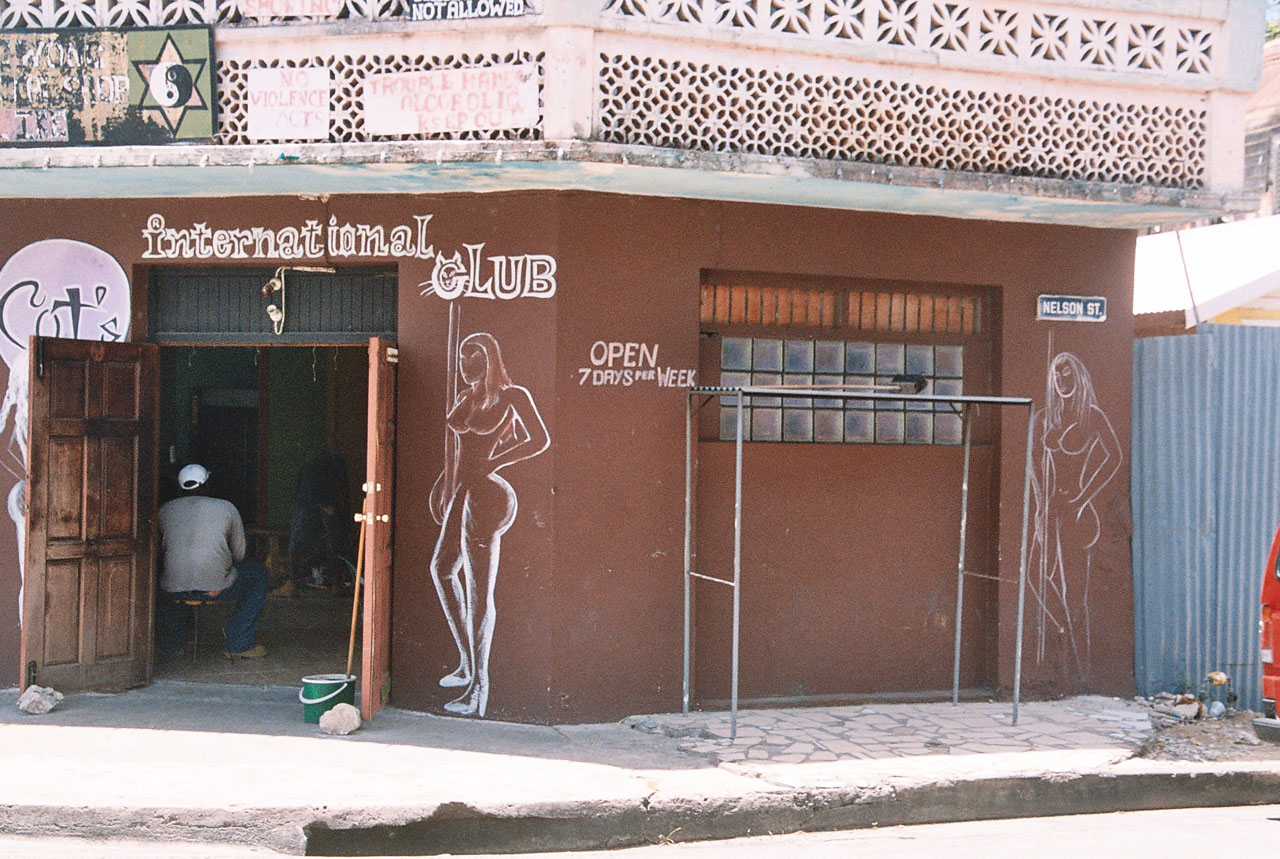


It was certainly around Nelson Street where Lilian picked up her trade, who were, for the most part, of course, sailors on shore leave. Prostitution in the port of Bridgetown was extremely common, though the area around Nelson Street was mostly a black area, and a white prostitute was the exception.
An illustration of the poverty prevalent in Barbados is this photograph of 1904-1907. Barbadian labourers thronging at the quayside at Bridgetown to go to work on the Panama Canal.

Lilian's path in life was probably not one which was going to lead to longevity, and she died in 1909, aged 46, in Waterloo Alley, Bridgetown:

Waterloo Alley is circled in purple below:

Lilian was buried in Westbury Cemetery, as her mother Selina had been eight years earlier.
Is that the end of the story?
No, no, no - not a bit of it, because family history always has a new surprise waiting for us. Lilian died on 16 May 1909. Less than eight weeks later we find a little waif, not yet four years old, apparently travelling alone on a ship bound for Southampton, England: Daisy Partleton:

So this story moves on. Henry Partleton probably died in the 1860's. His wife Selina Matthews died in the poorhouse in 1901. His daughter Lilian was so poor she had to resort to prostitution and died in 1909 aged 46.
But who is this new member of the family? Daisy had been born in 1905 when Lilian was 41. Is she another of Lilian's children?
Click here to read about Daisy and to continue with the odyssey of the Partleton family in Barbados.
If you enjoyed reading this page, you are invited to 'Like' us on Facebook. Or click on the Twitter button and follow us, and we'll let you know whenever a new page is added to the Partleton Tree:
Do YOU know any more to add to this web page? Or would you like to discuss its contents?... why not send us an email to partleton@yahoo.co.uk
Click here to return to the Partleton Tree Home Page
